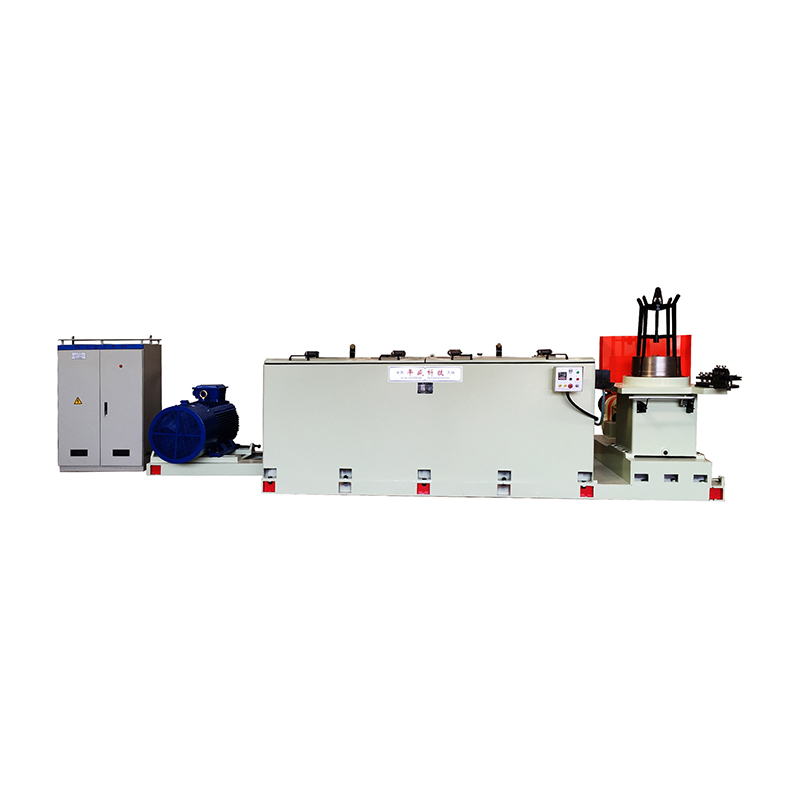Wet wire drawing machine: the core equipment of metal wire processing
In the field of metal wire processing, wet wire drawing machine is an indispensable equipment. It reduces the diameter and smoothes the surface of the metal wire by passing it through the die and applying tension, while using lubricating fluid to reduce friction and heat, ensuring the efficiency of the processing process and product quality. Wet wire drawing machine is widely used in the production of metal wires such as steel wire, copper wire, and aluminum wire, providing high-quality basic materials for industries such as automobile manufacturing, construction, and electronics.
Wet wire drawing machine usually consists of the following key parts:
Wire drawing die: used to determine the final size and shape of the wire.
Lubrication system: provides continuous lubricating fluid to ensure smooth processing.
Traction device: controls the feed speed and tension of the wire.
Cooling system: prevents the performance of the wire from deteriorating due to high temperature.
Working principle of wet wire drawing machine
The core working principle of wet wire drawing machine is based on cold processing technology, which causes plastic deformation of metal wire by drawing. The following is its main workflow:
Pretreatment
Before drawing, metal wires need to go through cleaning, annealing or other pretreatment steps to remove surface oxide layers and impurities and improve the quality of subsequent processing.
Lubrication and cooling
Before the wire enters the drawing die, it will be coated with a layer of lubricant. The lubricant not only reduces friction, but also plays a cooling role to prevent the high temperature generated by high-speed drawing from affecting the performance of the wire.
Drawing process
The wire passes through a series of drawing dies with gradually decreasing apertures and is stretched to the required diameter under the action of a traction device. Each die is precisely designed to ensure that the wire gradually reaches the target size.
Post-processing
After drawing, the wire will be cleaned, dried and coated again to improve its corrosion resistance and appearance quality.

Features of wet wire drawing machine
High-precision processing
The wet wire drawing machine can achieve micron-level size control to ensure that the diameter of the wire is uniform and the surface is smooth. This high-precision processing capability makes it the preferred equipment for the production of high-end metal products.
Efficient lubrication and cooling
The use of lubricating fluid significantly reduces the friction coefficient between the die and the wire, reducing energy consumption and die wear. At the same time, the cooling system effectively controls the processing temperature and avoids thermal deformation and internal stress.
Versatility
Wet wire drawing machines are suitable for a variety of metal materials, including steel, copper, aluminum and their alloys. By replacing different dies and adjusting parameters, the needs of different specifications and uses can be met.
Environmental protection and energy saving
Modern wet wire drawing machines generally adopt a circulating lubrication system to reduce the waste of lubricating fluid. In addition, efficient cooling technology also reduces energy consumption, which is in line with the development trend of green environmental protection.
Application areas of wet wire drawing machines
Steel industry
In the steel industry, wet wire drawing machines are mainly used to produce high-strength steel wires, such as tire cords, spring steel wires and steel strands. These steel wires have excellent mechanical properties and are widely used in automobiles, construction, bridges and other fields.
Wire and cable industry
Copper wire and aluminum wire are the main raw materials for wires and cables, and wet wire drawing machines are key equipment for the production of these wires. Through the wet wire drawing process, metal wires with excellent conductive properties and smooth surface can be obtained.
Precision manufacturing
In the manufacture of precision instruments, medical devices and electronic components, wet wire drawing machines can be used to produce ultra-fine metal wires such as micro springs, connectors and sensor components.
Decoration and crafts
Wet wire drawing machines can also be used to produce high-quality decorative metal wires, such as jewelry chains, woven meshes and art sculptures, giving the products unique visual effects and textures.
Market trends and development prospects
With the development of industrial automation and intelligence, wet wire drawing machines are moving towards a more efficient and intelligent direction. Here are some trends worth paying attention to:
Intelligent upgrade
Modern wet wire drawing machines are increasingly integrating sensors, PLC control systems and data analysis software, realizing real-time monitoring, fault diagnosis and parameter optimization, greatly improving production efficiency and product quality.
New material processing
With the popularization of new metal materials (such as titanium alloys and magnesium alloys), wet wire drawing machines need to adapt to higher hardness and complexity requirements, which has promoted the innovation of equipment design and process technology.
Green Manufacturing
The increasingly stringent environmental regulations have prompted manufacturers to develop more energy-saving and environmentally friendly wet wire drawing machines. For example, biodegradable lubricating fluids and low-energy drive systems are used to reduce the impact on the environment.
Customized Solutions
Different industries have different requirements for wires, and future wet wire drawing machines will pay more attention to modular design to meet the personalized needs of customers.
As the core equipment for metal wire processing, wet wire drawing machines play a vital role in modern industry. Whether it is high-strength steel wire or precision copper wire, wet wire drawing machines can meet diverse needs with their high precision, high efficiency and versatility. With the continuous advancement of technology, wet wire drawing machines will make greater breakthroughs in intelligence, greening and customization, injecting new vitality into the metal processing industry. In the future, this equipment will surely continue to promote technological innovation in related fields and contribute to the sustainable development of human society.


 EN
EN
 English
English Español
Español Français
Français Português
Português عربى
عربى














